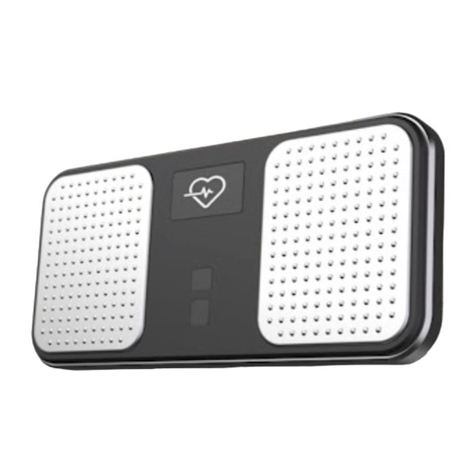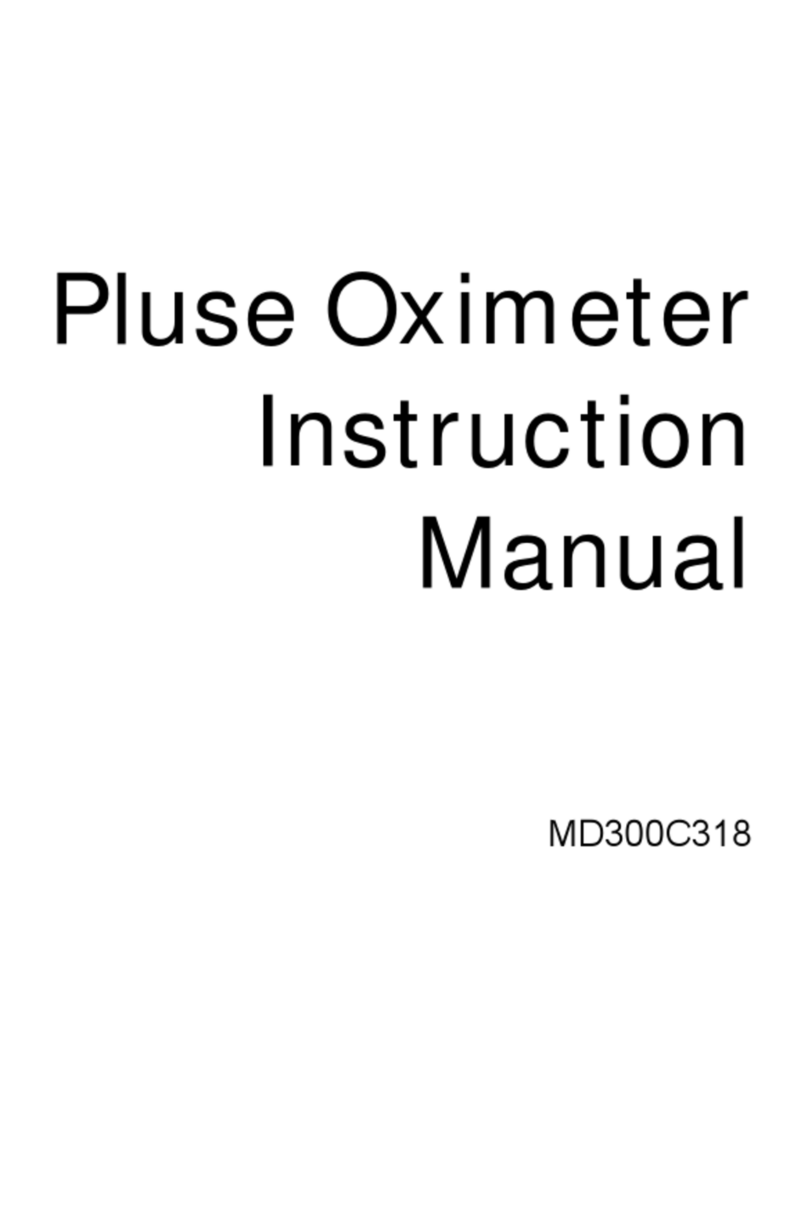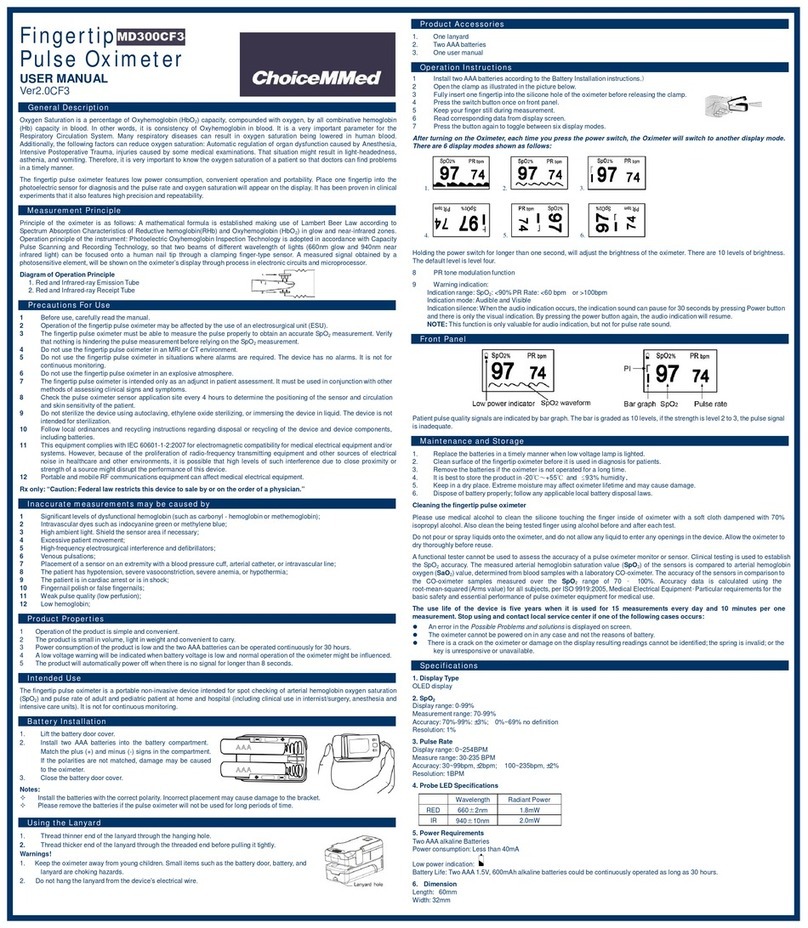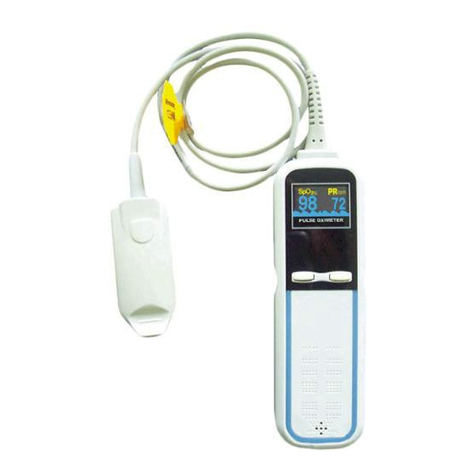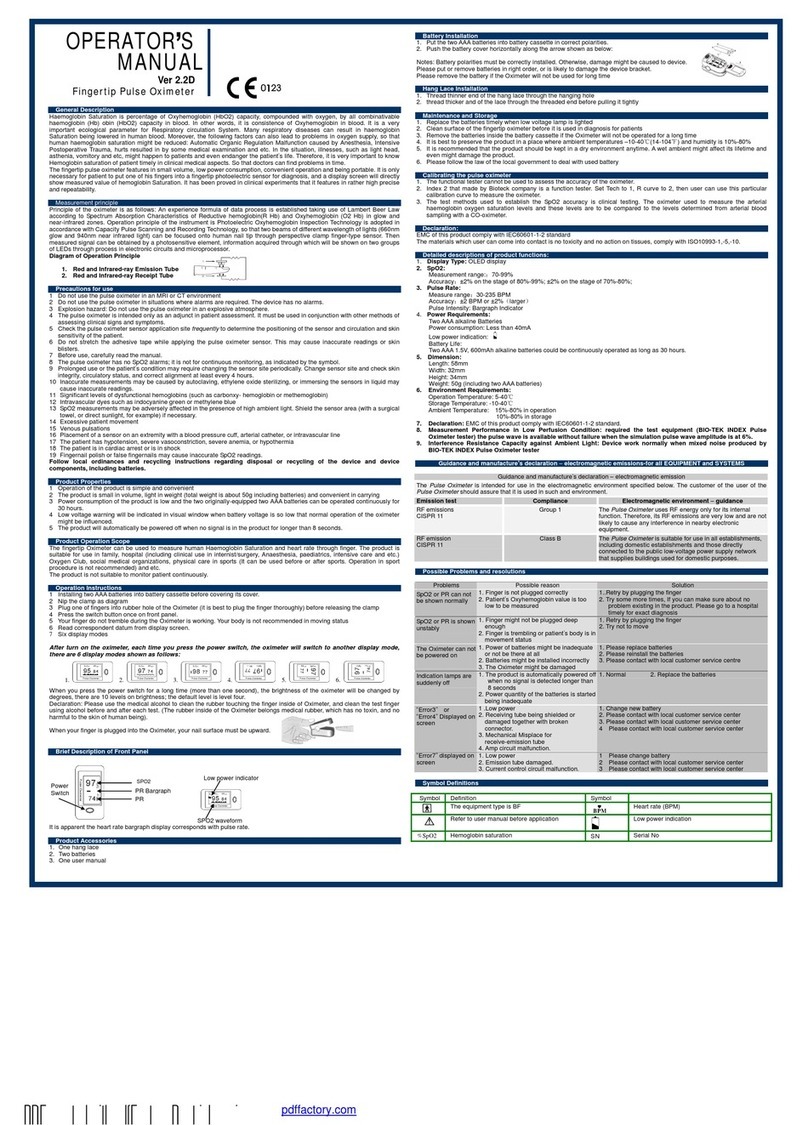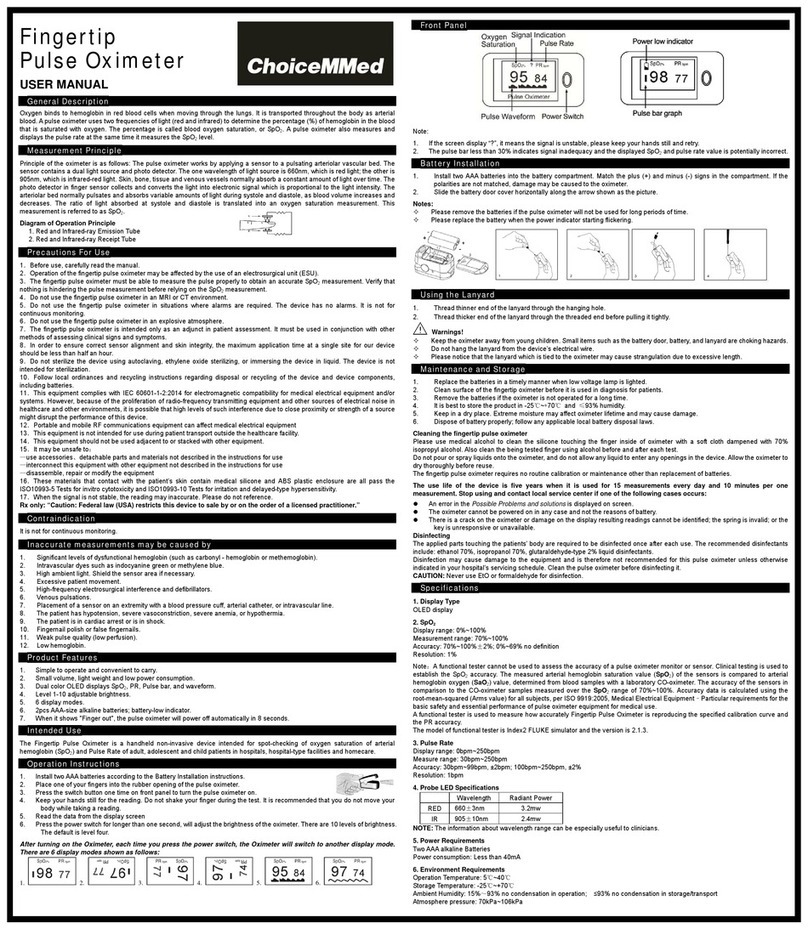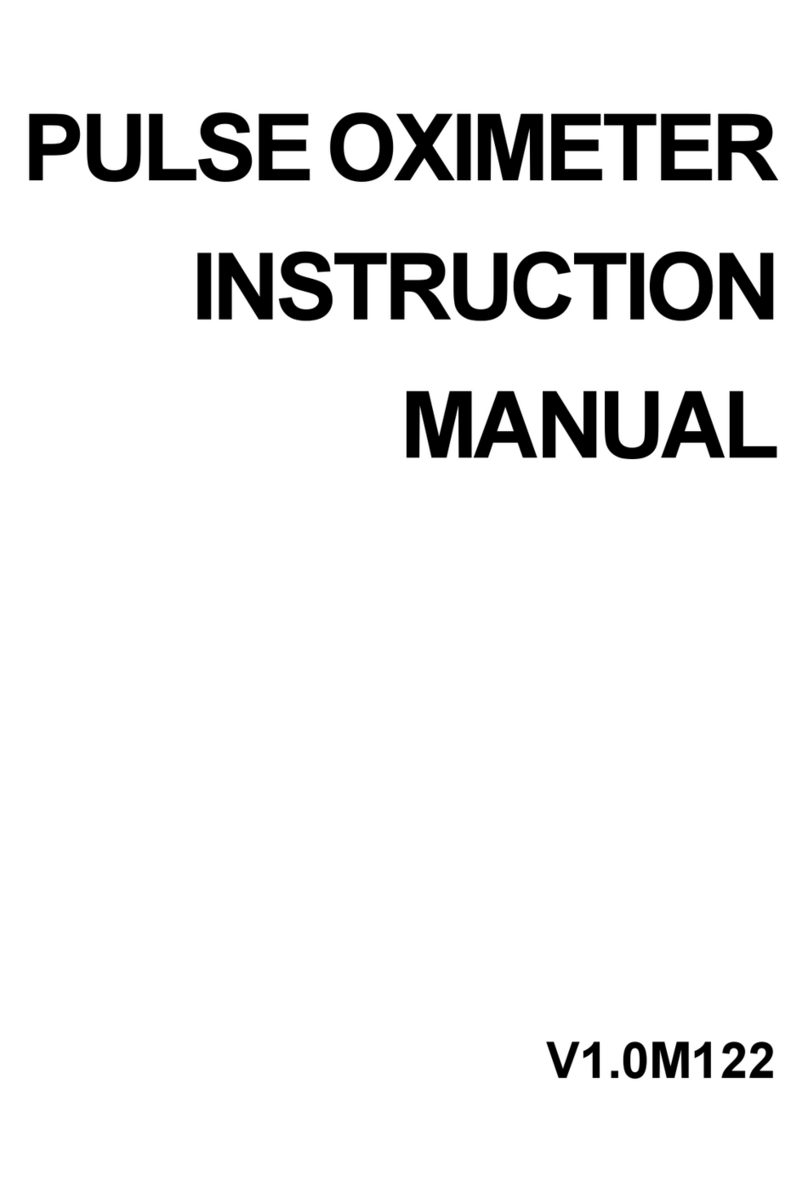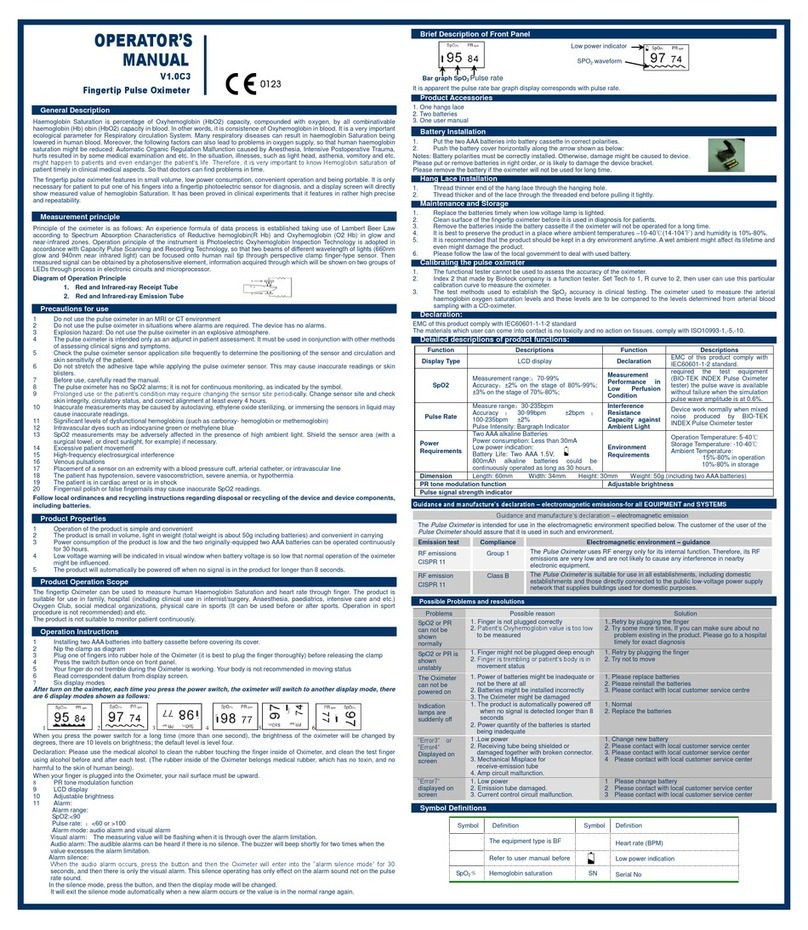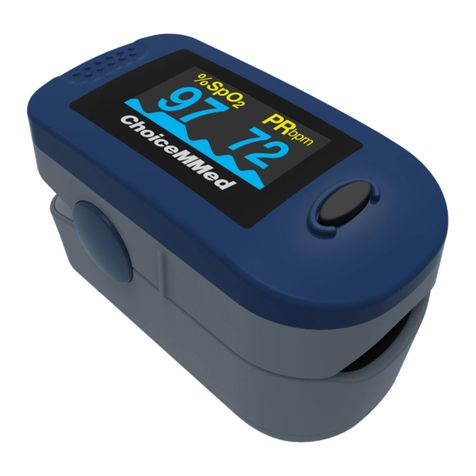Fingertip Pulse Oximeter
MD300C2ES USER MANUAL Ver1.0
General Description
Oxygen Saturation is a percentage of Oxyhemoglobin (HbO2) capacity, compounded with oxygen, by all combinative hemoglobin (Hb) capacity in blood. In other words, it is
consistency of Oxyhemoglobin in blood. It is a very important parameter for the Respiratory Circulation System. Many respiratory diseases can result in oxygen saturation being
lowered in human blood. Additionally, the following factors can reduce oxygen saturation: Automatic regulation of organ dysfunction caused by Anesthesia, Intensive Postoperative
Trauma, injuries caused by some medical examinations. That situation might result in light-headedness, asthenia, and vomiting. Therefore, it is very important to know the oxygen
saturation of a patient so that doctors can find problems in a timely manner.
The fingertip pulse oximeter features low power consumption, convenient operation and portability. Place one fingertip into the photoelectric sensor for diagnosis and the pulse rate
and oxygen saturation will appear on the display. It has been proven in clinical experiments that it also features high precision and repeatability.
Measurement Principle
Principle of the oximeter is as follows: A mathematical formula is established making use of Lambert Beer Law according to Spectrum Absorption Characteristics of Reductive
hemoglobin (RHb) and Oxyhemoglobin (HbO2) in red and near-infrared zones. Operation principle of the instrument: Photoelectric Oxyhemoglobin Inspection Technology is adopted in
accordance with Capacity Pulse Scanning and Recording Technology, so that two beams of different wavelength of lights (660nm red and 905nm near infrared light) can be focused
onto a human nail tip through a clamping finger-type sensor. A measured signal obtained by a photosensitive element, will be shown on the oximeter’s display through process in
electronic circuits and microprocessor.
Diagram of Operation Principle
1. Red and Infrared-ray Emission Tube
2. Red and Infrared-ray Receipt Tube
Precautions For Use
1Before use, carefully read the manual.
2Operation of the fingertip pulse oximeter may be affected by the use of an electrosurgical unit (ESU).
3The fingertip pulse oximeter must be able to measure the pulse properly to obtain an accurate SpO2measurement. Verify that nothing is hindering the pulse measurement
before relying on the SpO2measurement.
4Do not use the fingertip pulse oximeter in an MRI or CT environment.
5Do not use the fingertip pulse oximeter in situations where alarms are required. The device has no alarms. It is not for continuous monitoring.
6Do not use the fingertip pulse oximeter in an explosive atmosphere.
7The fingertip pulse oximeter is intended only as an adjunct in patient assessment. It must be used in conjunction with other methods of assessing clinical signs and symptoms.
8In order to ensure correct sensor alignment and skin integrity, the maximum application time at a single site for our device should be less than half an hour.
9Do not sterilize the device using autoclaving, ethylene oxide sterilizing, or immersing the device in liquid. The device is not intended for sterilization.
10 Follow local ordinances and recycling instructions regarding disposal or recycling of the device and device components, including batteries.
11 This equipment complies with IEC 60601-1-2:2007 for electromagnetic compatibility for medical electrical equipment and/or systems. However, because of the proliferation of
radio-frequency transmitting equipment and other sources of electrical noise in healthcare and other environments, it is possible that high levels of such interference due to
close proximity or strength of a source might disrupt the performance of this device.
12 Portable and mobile RF communications equipment can affect medical electrical equipment.
13 This equipment is not intended for use during patient transport outside the healthcare facility.
14 This equipment should not be used adjacent to or stacked with other equipment.
15 It may be unsafe to:
—use accessories、detachable parts and materials not described in the instructions for use
—interconnect this equipment with other equipment not described in the instructions for use
—disassemble, repair or modify the equipment.
16 These materials that contact with the patient’s skin contain medical silicone and ABS plastic enclosure are all pass the ISO10993-5 Tests for invitro cytotoxicity and
ISO10993-10 Tests for irritation and delayed-type hypersensitivity.
Contraindication
It is not for continuous monitoring.
Inaccurate measurements may be caused by
1Significant levels of dysfunctional hemoglobin (such as carbonyl - hemoglobin or methemoglobin).
2Intravascular dyes such as indocyanine green or methylene blue.
3High ambient light. Shield the sensor area if necessary.
4Excessive patient movement.
5High-frequency electrosurgical interference and defibrillators.
6Venous pulsations.
7Placement of a sensor on an extremity with a blood pressure cuff, arterial catheter, or intravascular line.
8The patient has hypotension, severe vasoconstriction, severe anemia, or hypothermia.
9The patient is in cardiac arrest or is in shock.
10 Fingernail polish or false fingernails.
11 Weak pulse quality (low perfusion).
12 Low hemoglobin.
Product Properties
1 Simple to operate and convenient to carry.
2 Small volume, light weight and low power consumption.
3 High brightness OLED display SpO2, PR, and Pulse bar; two directions display mode.
4 2 display modes.
5 2pcs AAA-size alkaline batteries; battery-low indicator.
Intended Use
The Fingertip Pulse Oximeter is only for sports and aviation use. It is ideal for use during sports activities, mountain climbing and piloting airplanes. It is not intended to diagnosis any
medical condition or to be used in medical applications.
Operation Instructions
1 Install two AAA batteries according to the Battery Installation instructions.
2 Place one of your fingers into the rubber opening of the pulse oximeter.
3 Press the switch button one time on front panel to turn the pulse oximeter on.
4 Keep your hands still for the reading. Do not shake your finger during the test. It is recommended that you do not move your body while taking a reading.
5 Read the data from the display screen.
6 After take out the finger, the measurement data displays in the screen for 5 seconds and then the pulse oximeter will power off automatically in 5 seconds.
7 Press the button again to toggle between two display modes.
After turning on the Oximeter, each time you press the power switch, the Oximeter will switch to another display mode. There are 2 display modes shown as follows:
1. 2.
Holding the power switch for longer than one second, will adjust the brightness of the oximeter. There are 10 levels of brightness. The default level is level four.
Front Panel
The pulse bar less than 30% indicates signal inadequacy and the displayed SpO2and pulse rate value is potentially incorrect.
Battery Installation
1. Install two AAA batteries into the battery compartment. Match the plus (+) and minus (-) signs in the compartment. If the polarities are not matched, damage may be caused to
the oximeter.
2. Slide the battery door cover horizontally along the arrow shown as the picture.
Note:
Please remove the batteries if the pulse oximeter will not be used for long periods of time.
Please replace the battery when the low battery power indicator.
Using the Lanyard
1. Thread thinner end of the lanyard through the loop.
2. Thread thicker end of the lanyard through the threaded end before pulling it tightly.
Warnings!
Keep the oximeter away from young children. Small items such as the battery door, battery, and lanyard are choking hazards.
Do not hang the lanyard from the device’s electrical wire.
1. Please notice that the lanyard which is tied to the oximeter may cause strangulation due to excessive length.
Maintenance and Storage
1. Replace the batteries in a timely manner when low voltage lamp is lighted.
2. Clean surface of the fingertip oximeter before it is used in diagnosis for patients.
3. Remove the batteries if the oximeter is not operated for a long time.
4. It is best to store the product in -20℃~+55℃and ≤93% humidity.
5. Keep in a dry place. Extreme moisture may affect oximeter lifetime and may cause damage.
6. Dispose of battery properly; follow any applicable local battery disposal laws.
Cleaning the fingertip pulse oximeter
Please use medical alcohol to clean the silicone touching the finger inside of oximeter with a soft cloth dampened with 70% isopropyl alcohol. Also clean the being tested finger using
alcohol before and after each test.
Do not pour or spray liquids onto the oximeter, and do not allow any liquid to enter any openings in the device. Allow the oximeter to dry thoroughly before reuse.
The use life of the device is five years when it is used for 15 measurements every day and 10 minutes per one measurement. Stop using and contact local service center if
one of the following cases occurs:
An error in the Possible Problems and solutions is displayed on screen.
The oximeter cannot be powered on in any case and not the reasons of battery.
There is a crack on the oximeter or damage on the display resulting readings cannot be identified; the spring is invalid; or the key is unresponsive or unavailable.
Specifications
1. Display Type
OLED display
2. SpO2
Display range: 0%~100%
Measurement range: 70%~100%
Accuracy: 70%~100%: ±2%; 0%~69% no definition
Resolution: 1%
ARMS Value Analysis
